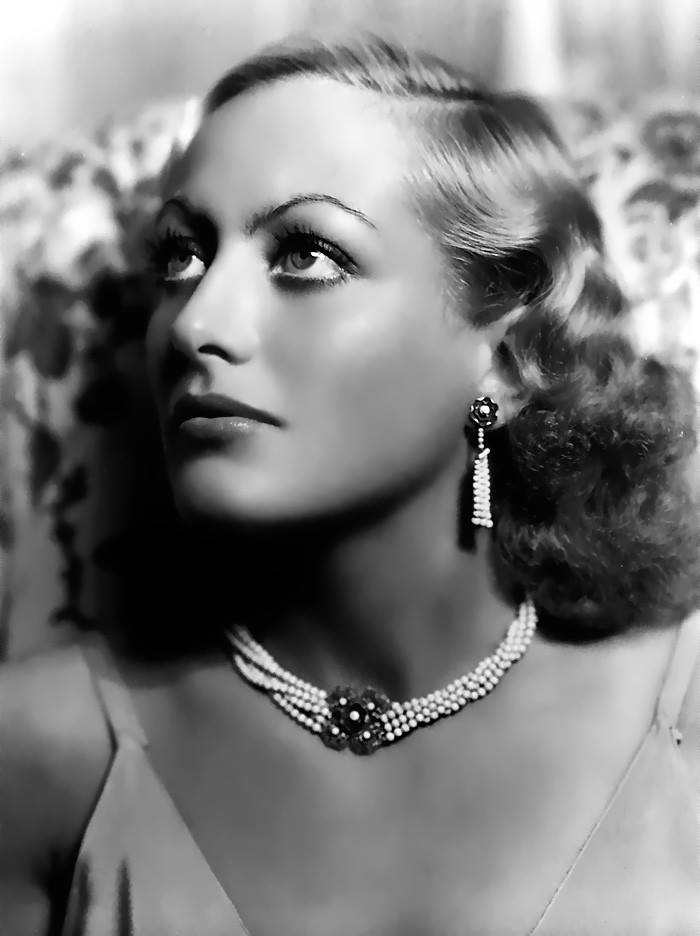When the woman, her longtime housekeeper, Mamacita realized that Joan was dying, she began praying softly, then a bit louder. Joan heard the words, and said, “Dammit, don’t you dare ask God to help me.” She died shortly after that.
Upon hearing of Crawford’s death, Davis allegedly remarked, “You should never say bad things about the dead, you should only say good. Joan Crawford is dead. Good!”
Joan Crawford (born Lucille Fay LeSueur; March 23,1904 – May 10, 1977) was an American film and television actress who began her career as a dancer and stage showgirl. In 1999, the American Film Institute ranked Crawford tenth on its list of the greatest female stars of Classic Hollywood Cinema.
Beginning her career as a dancer in traveling theatrical companies, before debuting as a chorus girl on Broadway, Crawford signed a motion picture contract with Metro-Goldwyn-Mayer in 1925. In the 1930s, Crawford’s fame rivaled, and later outlasted, MGM colleagues Norma Shearer and Greta Garbo. Crawford often played hard-working young women who find romance and success. These stories were well received by Depression-era audiences and were popular with women. Crawford became one of Hollywood’s most prominent movie stars and one of the highest-paid women in the United States, but her films began losing money and, by the end of the 1930s, she was labelled “box office poison”. But her career gradually improved in the early 1940s, and she made a major comeback in 1945 by starring in Mildred Pierce, for which she won the Academy Award for Best Actress. She would go on to receive Best Actress nominations for Possessed (1947) and Sudden Fear (1952). She continued to act in film and television throughout the 1950s and 1960s; she achieved box office success with the highly successful horror film Whatever Happened To Baby Jane? (1962), in which she starred alongside Bette Davis, her long-time rival.
In 1955, Crawford became involved with the Pepsi-Cola Company through her marriage to company Chairman Alfred Steele. After his death in 1959, Crawford was elected to fill his vacancy on the board of directors, serving until she was forcibly retired in 1973. After the release of the British horror film Trog in 1970, Crawford retired from the screen. Following a public appearance in 1974, after which unflattering photographs were published, Crawford withdrew from public life and became increasingly reclusive until her death in 1977.
Crawford married four times. Her first three marriages ended in divorce; the last ended with the death of husband Alfred Steele. She adopted five children, one of whom was reclaimed by his birth mother. Crawford’s relationships with her two elder children, Christina and Christopher, were acrimonious. Crawford disinherited the two, and, after Crawford’s death, Christina wrote a well-known “tell-all” memoir titled Mommie Dearest (1978.)
Born Lucille Fay LeSueur in San Antonio, Texas, the youngest and third child of Anna Bell (Johnson) and Thomas E. LeSueur, a laundry laborer. She was of English, French Huguenot, Swedish, and Irish ancestry. Crawford’s elder siblings were sister Daisy LeSueur, who died before Lucille’s birth, and brother Hal LeSueur.
The enmity between Davis and Crawford created one of the most famous celebrity feuds of all time.
Why did they hate each other so much? Well, it’s a long story.
Crawford was already a big star when Davis was making her first appearances in movies. Joan had slept her way to the top, and gone as far as marrying the legendary Douglas Fairbanks Jr. Davis was irritated by the way that the newspapers seemed so obsessed with Crawford’s love life, and she was especially put out the time that the studio had arranged a big publicity stunt for Davis’s new movie Ex-Lady only for Crawford to steal the headlines by announcing on the same day that she and Fairbanks were divorcing.
Bette had been jealous of Crawford’s affair with Clark Gable, on whom she had a crush, but it was Franchot Tone who the two really fell out over. Tone, who was dating Crawford, was Davis’s leading man in Dangerous. Davis fell in love with him, but he married Crawford.
Eventually, Davis became a huge star, overtaking Crawford. By the 1940s both stars were employed by the same studio, Warner Bros., where they had adjoining dressing rooms. Crawford did her best to win Davis over, sending a stream of flowers and gifts next door, but all were returned (with Davis making sneering remarks about “lesbian overtures”). The rivalry and bitchiness soon started to become obvious, and before long it was legendary. They bitched about each other’s appearance, love-lives, upbringing, careers, awards, and even each other’s children.
Joan Crawford wasn’t known for her love of Black people, with the exception of Black men, of course, most notably, Harlem Gigolo Dicke Wells, she invited him often to her home when he was in town.
Written by Dianne Washington

